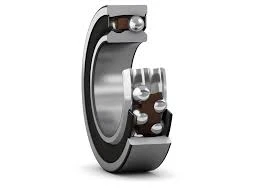
Nov . 15, 2024 11:03 Back to list
6003 bearing specification
Understanding the 6003 Bearing Specification
The 6003 bearing is a widely recognized component in various mechanical systems, primarily due to its versatile suitability and reliable performance. This deep groove ball bearing, a part of the 6000 series, is particularly favored in applications where reduced noise and minimal maintenance are crucial.
Design and Structure
The 6003 bearing features an inner diameter of 17 mm, an outer diameter of 35 mm, and a width of 10 mm. This specific size makes it a popular choice for electric motors, household appliances, and small machinery. The design often incorporates high-quality steel, providing significant durability and resistance to wear. Additionally, these bearings usually come with metal shields (ZZ) or rubber seals (2RS) that prevent the ingress of dirt and moisture, thus ensuring prolonged operational life.
Load Capacity and Performance
One of the key parameters in evaluating bearings is their load capacity. The 6003 bearing can handle both radial and axial loads, making it a versatile choice for different applications. Its dynamic load rating is approximately 7,200 N, while the static load rating is around 3,500 N, allowing it to support various weights and stresses. With a maximum speed of about 19,000 RPM, the 6003 bearing is suitable for high-speed applications, making it ideal for use in electric motors and pumps.
6003 bearing specification

Applications
The versatility of the 6003 bearing translates into a wide array of applications. It is commonly employed in lawn mowers, power tools, and conveyor systems, as well as automotive components and agricultural machinery. Because of its robust nature, it is also utilized in industries such as aerospace and manufacturing, where reliability and efficiency are paramount.
Installation and Maintenance
While using the 6003 bearing, proper installation is crucial to ensure optimal performance. It is essential to align the bearing correctly and apply the appropriate amount of lubrication. Regular maintenance checks should also be performed to monitor the condition of the bearing, checking for signs of wear, noise, or overheating. Taking these steps can significantly extend the lifespan of the bearing and optimize the performance of the machinery in which it is installed.
Conclusion
In summary, the 6003 bearing specification encapsulates a product that is not only efficient and reliable but also adaptable across various industries and applications. With its robust design, impressive load capacity, and ease of maintenance, the 6003 bearing stands out as a fundamental component in modern mechanical systems. Understanding its features and capabilities enables engineers and technicians to make informed decisions when selecting bearings for their projects, ultimately leading to enhanced performance and longevity of machinery.
Latest news
-
Premium Deep Groove Ball Bearings | High Speed & Reliability
NewsAug.29,2025
-
Durable Scaffolding Clamps - Secure & Reliable Tube Connectors
NewsAug.28,2025
-
Common Failures in Thrust Ball Bearings and Solutions
NewsAug.22,2025
-
How Tapered Roller Bearings Can Take Shock Loads
NewsAug.22,2025
-
Angular Bearings in High-Precision Spindles
NewsAug.22,2025
-
The Impact of Misalignment on Cylindrical Roller Bearing Performance
NewsAug.22,2025
